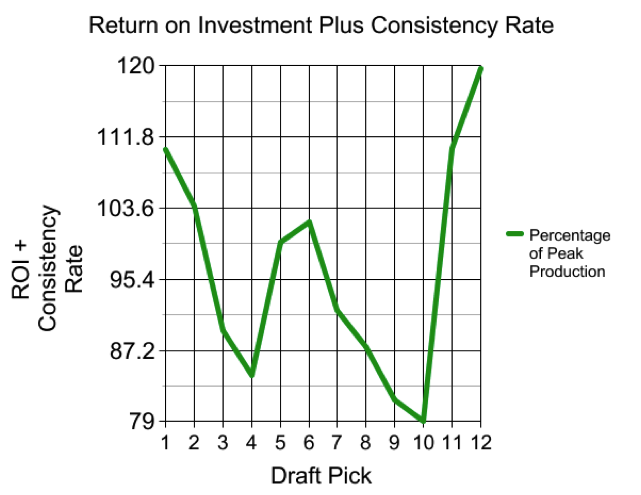This article is part of our According to the Data series.
Which Draft Slot is Most Valuable? A Follow-Up Analysis
You've waited all summer for your big fantasy football draft. All of the prep work is finished - projections, tiered rankings, consistency calculations. Yup, you're certain the countless hours of work you put in will give you a leg up on the competition... Except you just found out you have the 12th overall pick. Season over.
While nothing can be quite a buzzkill like landing a less-than-ideal draft spot, chances are the pick you own might be better - or worse - than you think. Last week, I published an article that attempted to calculate which draft spots have been the best over the last half-decade. You can consult that article for more information, but here are the results:

Over the past five years, the 12th draft spot has actually provided the greatest return on investment in the first two rounds. The No. 12 and No. 13-ranked players you can acquire in that slot have provided a greater percentage of optimal production than any other set of first-two-round snake draft picks, including the first and 24th. With the increasing popularity of third-round reversal drafts in which the No. 12 overall pick selects first in both the second and third rounds, the value of the 12th draft spot soars even higher.
Of course, fantasy football isn't all about averages. It's useful to know the return provided by each draft slot, but it's just as useful to understand the consistency with which they
Which Draft Slot is Most Valuable? A Follow-Up Analysis
You've waited all summer for your big fantasy football draft. All of the prep work is finished - projections, tiered rankings, consistency calculations. Yup, you're certain the countless hours of work you put in will give you a leg up on the competition... Except you just found out you have the 12th overall pick. Season over.
While nothing can be quite a buzzkill like landing a less-than-ideal draft spot, chances are the pick you own might be better - or worse - than you think. Last week, I published an article that attempted to calculate which draft spots have been the best over the last half-decade. You can consult that article for more information, but here are the results:

Over the past five years, the 12th draft spot has actually provided the greatest return on investment in the first two rounds. The No. 12 and No. 13-ranked players you can acquire in that slot have provided a greater percentage of optimal production than any other set of first-two-round snake draft picks, including the first and 24th. With the increasing popularity of third-round reversal drafts in which the No. 12 overall pick selects first in both the second and third rounds, the value of the 12th draft spot soars even higher.
Of course, fantasy football isn't all about averages. It's useful to know the return provided by each draft slot, but it's just as useful to understand the consistency with which they provide that return. That is, we want to know not only how many points we can expect to receive from the players drafted in each spot, but also how likely they are to reach certain thresholds. A draft slot that returns 65 percent of peak production might be superior to one that returns 70 percent if the former can provide that 65 percent return very consistently.
In short, we want to know the "bust rate" associated with each draft slot. Below, I tracked how often over the past five years each draft spot was able to provide two players with a 70 percent minimum return in the first two rounds.

You can see that, once again, the 12th pick has been the most profitable. Choosing from that slot, owners have been able to grab two players that have scored at least 70 percent of what the top players at their respective positions scored 44.9 percent of the time. That's the highest rate of any draft spot, with the No. 1 (and No. 24) overall selection coming in second at 40.0 percent.
In my original analysis on overall return, I argued that after the first two draft picks, there isn't much of a difference between picks No. 3 through No. 12. In terms of consistency, however, the results are a bit different. Since, 2007, owners selecting with the No. 3 overall pick have been able to draft two players with at least a 70 percent return almost 70 percent more often than owners choosing in the No. 8, No. 9 and No. 10 spots. In terms of consistency, the middle of the draft appears to be the worst place from which to draft.
And there's a lot to be said about consistency. In the early rounds, owners should try to be as safe as possible, choosing players who are unlikely to be busts, even if it means sacrificing upside. The potential ceiling of the draft's highest picks is very small relative to the cost; the best the No. 1 overall pick can do, for example, is give you what you paid for. Thus, it's critical for owners to limit players' floors, i.e. draft conservatively. The middle and late rounds are the times to take on risk.
Ultimately, the shrewdest owners are the ones who can manage to limit risk without dramatically decreasing upside. Thus, both return on investment and consistency are important factors in drafting. If we combine the results from both studies by adding the hit rate for each draft slot to the overall return of investment from the first two picks, we get the following results:

So what are we left with here? Which draft slot is the "best"? Although I think every season is different, and the value of each draft pick is inherently fluid, there's definitely some value in choosing at either the top or bottom of the draft.
With either of the first two picks, you get consistency. You're almost guaranteed a top-level player, and that sort of "sure thing" isn't there after the first couple of picks.
When I wrote my original article last week, I argued that in the first round, draft picks No. 3 through No. 12 have historically been pretty similar. The extra advantage that comes with a late first-round pick, however, is an early second-round pick. Since the drop-off of top-tier talent has historically been in the 13-14 range, it means you can grab two studs (not the elite kind at the top of the draft, but a Darren McFadden/Cam Newton-type combo). When choosing in the middle of the first round, you have to forgo the consistency that accompanies the top two selections, but you don't reap the benefits of an early second-round pick.
Jonathan Bales is the author of Fantasy Football for Smart People: How to Dominate Your Draft. He also runs the "Running the Numbers" blog at DallasCowboys.com and writes for the New York Times.










